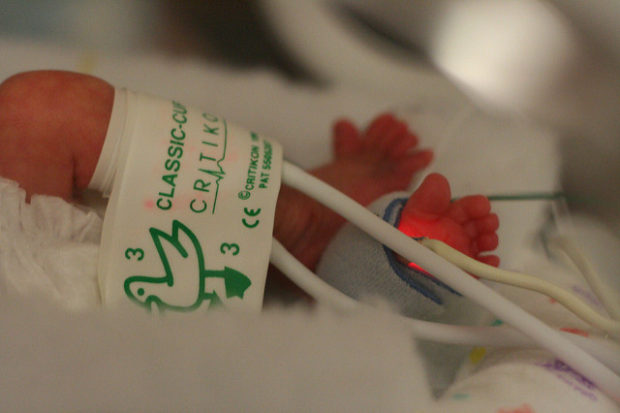Incubated from the World: HILA RATZABI’s Premature Birth Story
Through a haze of painkillers, I awoke in the postpartum room to the sound of the news on TV: hundreds murdered in Paris. I struggled to compute the brokenness in the world outside the hospital, but inside my world had already shattered. Three days earlier I had given birth to my premature baby, at the gestational age of 33 weeks and 6 days. A week before that I had gone into preterm labor at 33 weeks. A full day of contractions (I initially thought it was back pain) ended in a trip to the hospital. A doctor examined me internally, and as she looked up, her bottom lip quivered: I’m sorry to tell you, you’re four centimeters dilated. She explained that it was likely I would deliver the baby soon. I remember saying to my husband over and over, It’s too early. It’s not supposed to happen now. I pressed my hands against my thighs to try to stop them from shaking.
After getting steroid shots to help the baby’s lungs mature, because breathing issues are a primary concern with preemies, and receiving a tocolytic medication to stop contractions, I remained in the hospital for monitoring. Luckily, the contractions did stop, and after a few days I was sent home, not technically on bed rest, but instructed to sit tight. The labor could return at any time.
A week later I went into labor again, and I knew this was really it. I felt slightly less terrified, since I’d had a “practice run” the week before. I was relieved we had gained an extra week for the baby to continue to develop in the womb. A pediatrician from the intensive care nursery (ICN) had explained that from her perspective 33 weeks gestational age was excellent; the baby had very good chances of doing well. Now that I was close to 34 weeks, we felt confident that the baby would be okay. But we had no idea how tumultuous the birth and subsequent weeks of recovery for myself my baby would be, both physically and psychologically.
Contractions increased slowly and rhythmically, with breaks in between, just like the pregnancy books had described. With the help of my husband and doula, I made my way through the contractions, as they grew more and more intense. When the intensity rose to a level that was truly out of this world, and breaks seemed nonexistent, I asked for the epidural and happily received it.
But it turned out the baby was in distress. The doctors wanted to speed up the labor by breaking my water, and then, at nine centimeters dilation, they had me try to push to bring the baby down. After a few tries to no avail, they determined a c-section was necessary. This was the last thing I wanted, but it was clear I had no choice. By this point, I felt so helpless as to the way the birth was unfolding, my agency slipping away at each step of the process. In the same way that the epidural numbed the physical pain, I was becoming emotionally numb. I just wanted this over with.
I trusted the doctors to do the right thing (and they did, because later they discovered the umbilical chord had been wrapped around the baby’s neck). I was rolled into the operating room, and under bright lights the surgery began. I felt the tugging you’re told you will feel as the uterus is cut and the baby removed, but no pain. My baby was presented to me for a brief moment before he was whisked away. This much, at least, I had been prepared for.
But what happened next I never could have anticipated. As the doctors began rearranging my organs and sewing me back up, which took about twenty to thirty minutes, my epidural wore off. I felt everything. It was like being torn apart by wolves. I said over and over that I could feel what was happening and I needed them to increase the epidural. The doctor watching over me said I had been given the appropriate amount and could not receive more, which made no sense to me. He offered a sedative that would make me drowsy, and I refused; I was afraid to fall asleep. Finally, I allowed him to give me a low dosage of morphine that did nothing for the pain. When the surgery was finally over, the baby was brought for me to see briefly, but after that I was told I couldn’t see my baby till the next morning, twelve hours later.
I spoke to many doctors about the epidural wearing off, and I kept hearing the same explanation: that this happens to some people but not others, and they don’t know why. This was not a satisfying answer, but it was all I had. A few months after the birth, I attended a c-section healing circle run by a nurse. When I told my birth story and mentioned that the epidural had worn off, the nurse kindly corrected me. She said that when you receive an epidural for a c-section some people experience “windows,” or areas where you still feel sensation. I wish someone had warned me about this before hand, but it was comforting to know that I what I had experienced was normal. At the time it was happening I was confused and scared, and no one was able to adequately reassure me that everything was normal.
After I was able to see and hold my new baby, I was much too distracted to fully process the birth experience, and I was grateful to have made it through, along with my baby. However, the emotional numbness continued; I tabled the trauma of the c-section and turned my attention to what came next, which proved to be more of a drawn out kind of torture: waiting for my baby to be discharged from the ICN and come home.We were given the impression that he would only be there for a week or two. Our baby was monitored for typical preemie issues: jaundice, learning how to feed, gaining weight, and establishing normal breathing patterns. This last issue, bradycardia, was what kept our baby in the ICN for longer than we’d expected. These little dips in heart rate, which preemies eventually grow out of, must be monitored closely; there was no way to know when his breathing patterns would mature and he would be sent home.
My tasks during this uncertain time were to recover from the c-section, pump breast milk about ten times a day (getting little sleep), and visit my baby at the ICN as often as I was able. My daily life was governed by a series of alarms on my smart phone: take Percocet, pump, take iron pill, pump, take Percocet, pump, etc. At a certain point every day I would burst into tears, in agony of not having my baby home. My husband was equally shaken, and it’s unfathomable to me how we were able to plow through those endless days. People said we were so strong. My mother said, You are amazing in how you’re handling this. But I didn’t feel strong: I felt beaten and weak. I had no choice but to keep moving forward, though it felt like I was sinking in quick sand.
I continued to be haunted by the news from Paris and the general sense of the world collapsing around me. At times the hospital seemed like a safe space, protecting me and my baby from the ravages of the outside world. Other times it felt like a prison we’d never escape. In a sense we were both being incubated, gathering strength for whatever would come next.
Though we felt like we were living in a bubble—an alternate universe populated by wires, monitors, beeping noises, and scurrying nurses—we were not alone. Throughout this time, friends and family sent meals, listened to me cry, called, texted, and commented on Facebook with messages of support. When our baby finally came home, after five agonizing weeks, I could feel the joy and relief ripple through our community like a wave at a sports game. I think back to lying in my hospital bed, watching the incomprehensible and horrific news on TV. The depth of human depravity appears in stark contrast to the unconditional generosity of my support system. I never felt strong during that traumatic time, but I felt loved.
Over the course of those five weeks that he was in the ICN, and the weeks and months since he’s been home, I have watched my baby grow and thrive. He has filled out the newborn clothes that once hung loosely on his tiny body. He smiles and coos and gurgles and grasps. He is coming into his own strength, in the same way that I am slowly coming into my own.
I continue to watch the news in horror at the world from which I am trying to protect my son, the world that will eventually become his. While he lived in the ICN, I couldn’t wait for him to come home. Now that he’s home, I want to keep him here, safe, for as long as I can. Though I know it’s not possible, there are moments, particularly while breastfeeding, that we gaze at each other with a love that breaks me open. I want to put our lives on pause and keep my son forever in the sphere of that gaze. But just as soon as I try to hold that moment, his head turns to follow a shadow on the wall. I place him in the crib and before another day ticks by, I smooth the soft, soft hair on his head and walk out of the room.









